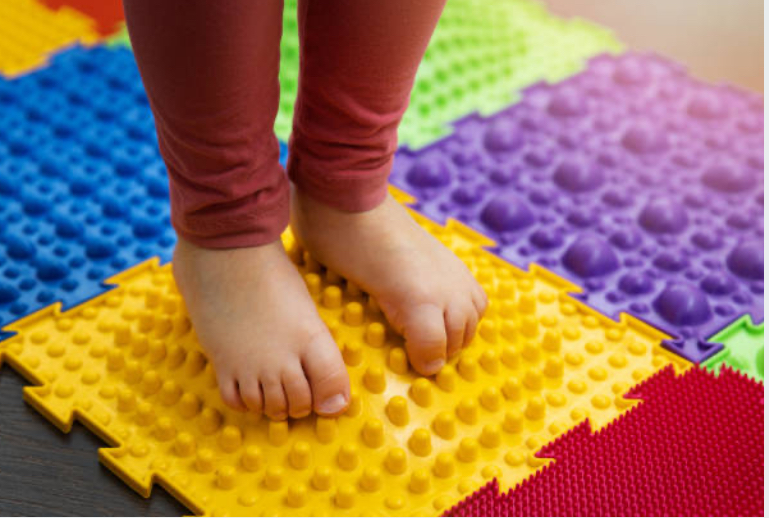Is your child constantly seeking textures to touch, or do they need a quiet, calming space to decompress? Perhaps you’re looking for unique ways to engage a child’s developing senses or provide therapeutic input. Enter the wonderful world of sensory mats! These versatile tools are more than just floor coverings; they’re gateways to exploration, regulation, and fun.
What are Sensory Mats?
At their core, sensory mats are padded surfaces designed to provide specific sensory input, primarily through touch (tactile) and deep pressure (proprioceptive). They often feature a variety of textures, shapes, and materials, inviting users to explore with their hands, feet, or even their whole body. From soft faux fur and bumpy silicone to cool gel and crinkly fabrics, sensory mats create a rich landscape for sensory discovery.
Why We Love Them!
Sensory mats are a fantastic addition to any home, classroom, or therapeutic setting for so many reasons:
- Engaging & Fun: They naturally invite curiosity and exploration, turning sensory input into an exciting adventure.
- Promote Exploration: They encourage children (and adults!) to engage actively with different textures and surfaces, enhancing their sensory processing skills.
- Safe & Defined Space: Many mats provide a designated “calm down” or “focus” zone, offering a secure area for sensory input without overwhelming the entire environment.
- Versatile: Suitable for a wide range of ages, from babies on tummy time to older children and even adults seeking sensory regulation.
- Portable: Many types are lightweight and easy to move, allowing for sensory experiences in different rooms or even on the go.
- Low-Tech & Effective: They offer powerful sensory benefits without requiring screens or complicated setups.
Unpacking the Sensory Benefits
Sensory mats offer a wealth of benefits across various sensory systems:
- Tactile System: This is the big one! Different textures provide varied input to the skin, helping with:
- Sensory Discrimination: Learning to differentiate between soft, rough, smooth, sticky, cool, warm, bumpy, etc.
- Desensitization (for tactile sensitivity): Gradual exposure to preferred textures can help individuals become more comfortable with a wider range of sensations.
- Sensory Seeking: Providing ample, safe input for those who crave tactile stimulation.
- Proprioceptive System: As you step, press, or roll on a sensory mat, your muscles and joints receive deep pressure input. This is fantastic for:
- Body Awareness: Understanding where your body is in space.
- Calming & Regulation: Deep pressure input is often very grounding and soothing for the nervous system.
- Motor Planning: Navigating uneven or varied surfaces helps plan movements.
- Vestibular System (Balance & Movement): While not all mats directly target this, those with uneven surfaces, squishy gels, or inflatable elements can subtly challenge balance and coordination.
- Visual System: Many mats feature contrasting colors, patterns, or even reflective surfaces, providing visual stimulation and encouraging visual tracking.
- Auditory System (Less Common): Some mats might incorporate crinkly materials or small squeakers, adding an auditory element.
- Emotional Regulation: By providing a safe and predictable source of sensory input, mats can help individuals calm down, focus, and manage their emotions more effectively.
Which Kind of Sensory Seekers Would Love Them?
Sensory mats are truly beneficial for a wide spectrum of sensory profiles:
- Tactile Seekers: Individuals who constantly touch everything, love messy play, or enjoy strong textures will thrive on the varied input.
- Tactile Avoiders: Surprisingly, mats can also be beneficial here! By starting with preferred, gentle textures and gradually introducing new ones, they can aid in desensitization in a controlled environment.
- Proprioceptive Seekers: Those who love to jump, crash, push, or crave deep pressure will find the firm, yielding surfaces of some mats incredibly satisfying and regulating.
- Vestibular Seekers (under-responsive): Mats that challenge balance (e.g., wobbly gel mats, uneven surfaces) can provide much-needed input for those who seek movement.
- Children with Sensory Processing Disorder (SPD) or Autism Spectrum Disorder (ASD): Mats can be tailored to provide specific, targeted sensory input that helps regulate their nervous system.
- Anyone Needing Calming or Focus: Whether it’s a child struggling to sit still or an adult needing a moment of mindful grounding, a sensory mat can offer therapeutic comfort.
- Early Explorers (Babies & Toddlers): Perfect for tummy time, crawling practice, and exploring cause-and-effect with different textures.
Types of Sensory Mats
The variety of sensory mats available is growing, catering to different needs and preferences:
- Textured Play Mats/Tiles: These are the most common, featuring various fabric textures (faux fur, velvet, corduroy, sandpaper-like), silicone bumps, ridges, or soft foam. Often interlocking, allowing for customizable paths.
- Liquid/Gel Mats: Filled with a safe, non-toxic liquid or gel that shifts and moves when pressed, creating mesmerizing visual effects and a squishy, calming tactile experience.
- Inflatable/Balance Mats: Designed with air chambers or wobbly surfaces to challenge balance and provide proprioceptive input, often used for therapeutic exercises.
- Activity/Baby Sensory Mats: Larger, often quilted mats designed for babies, incorporating crinkly sections, peek-a-boo flaps, rattles, and different textured fabric patches.
- DIY Sensory Paths/Walks: While not always “mats,” these often involve creating a path using various textured materials (rug samples, bubble wrap, sandpaper, foam, etc.) taped to the floor.
Our Top Rated Picks for Sensory Mats
While specific brands and products can vary in availability, here are some highly-regarded types of sensory mats that consistently receive excellent reviews for their quality, durability, and sensory benefits:
- Interlocking Textured Foam Tiles: Look for sets with diverse textures like “grass,” “stones,” “waves,” and “dots.” They are fantastic for creating customizable sensory paths.
- Liquid/Gel Floor Tiles: Popular for their mesmerizing visual appeal and squishy, calming tactile input. Ensure they are leak-proof and durable for active play.
- Sensory Squares: Offers a dedicated range of specific textures for more targeted tactile exploration.
Similar Sensory Delights You Might Like
If you love sensory mats, you’ll likely enjoy exploring these other sensory tools:
- Sensory Bins: Containers filled with various materials (rice, beans, water beads, sand) and small toys for hands-on tactile exploration.
- Fidget Toys & Chewies: Portable tools to help with focus, self-regulation, and provide oral motor input.
- Weighted Blankets & Lap Pads: Offer deep pressure input for calming and grounding, similar to the proprioceptive benefits of mats.
- Balance Boards & Discs: Standalone tools that further challenge the vestibular and proprioceptive systems, enhancing balance and coordination.
- Crash Pads: Large, soft mats designed for safe crashing and heavy work input, great for proprioceptive seekers.
- Bubble Tubes & Lava Lamps: Primarily visual sensory tools, offering calming and mesmerizing light displays.
- Sensory Tunnels & Tents: Provide a contained, calming space for sensory input, often incorporating textured fabrics or low lighting.
Sensory mats are a simple yet powerful way to bring enriching sensory experiences into any environment. Whether you’re looking to calm, engage, or simply provide a fun space for exploration, a sensory mat might just be the perfect addition!


